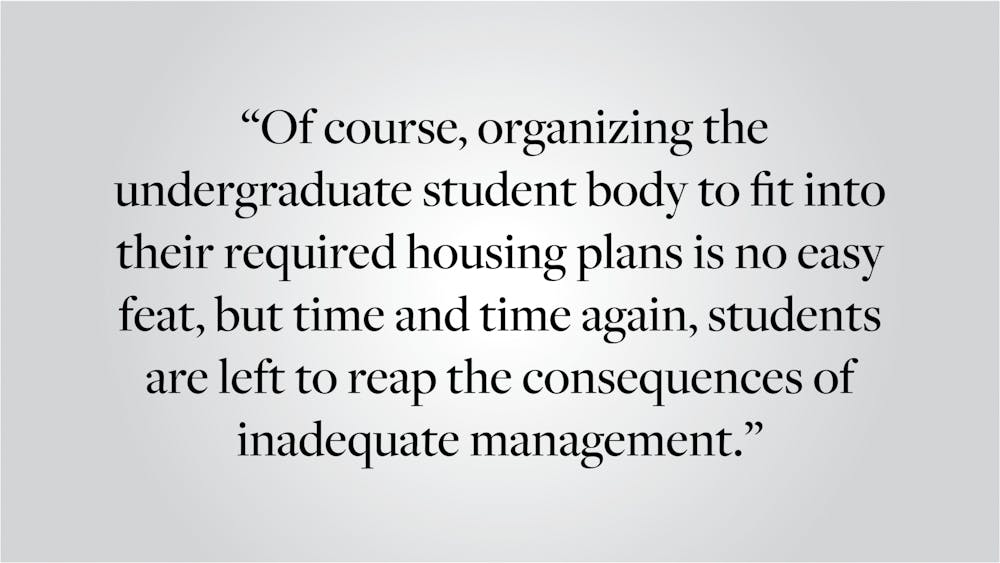Each spring, just after midterms, many Brown students enter perhaps the most stressful season of the year: housing selection. What should be a time of excitement in anticipation of the academic year to come is annually soiled by an inequitable cache of options, problematic power and resource dynamics and abysmal correspondence. These inequities, among others, signify the urgent need for Brown to reinvest and reallocate resources into the Office of Residential Life.
Decentralized and chronically uncommunicative, it seems like ResLife is often fighting against itself. Of course, organizing the undergraduate student body to fit into their required housing plans is no easy feat, but time and time again, students are left to reap the consequences of inadequate management. After this semester’s housing cycle, students, particularly those in the class of 2025, have been vocal about the weaknesses of the housing process across campus and all over social media. As a rising sophomore myself, it feels as if ResLife’s acute oversights have dominated the conversations I’ve had with friends and classmates. We all seem to have the same grievances and proposed solutions.
Like many universities, Brown’s bank of residential halls is far from uniform. What surprises many Brown students, though, is just how convoluted the process is. While some students breezed through the portal on the first day of the selection period, thrilled to claim their meticulously chosen suite in New Dorm, others were left to be sorted Hogwarts-style into the quarters of Perkins Hall — or worse, to tremblingly open the platform to a blank screen indicating that there were no rooms left.
Perhaps the most glaring of the inequities within Brown housing lies in the newly-opened Sternlicht Commons and the Health and Wellness Center. Not only do Wellness residents have easy access to Brown’s Health Services, Counseling and Psychological Services and Emergency Medical Services, but the culture of wellness living also exacerbates the disparities of support that students receive. Wellness aims to create a community of students who are perceived to already be “committed to developing and sustaining holistic, integrative wellbeing practices,” when it could serve as a space for students seeking support to develop and maintain these strategies. But for those in the lottery who realized that the air conditioning and brand new facilities of the Wellness Center were unattainable, the cramped singles and prison-like walls of the Graduate Center suddenly seemed desirable when the alternative became the uncertainty of having no housing assignment at all.
For first-years, the housing assignment process is pretty straightforward: Students receive an email shortly before the move-in date with a notice of whether they’ll be living in Keeney Quad (Archibald-Bronson, Everett-Poland, Jameson-Mead), or somewhere on north campus (Andrews, Miller, Metcalf, Morriss, Champlin, Emery and Woolley halls, as well as New Pembroke 4). In previous years, ResLife maintained this structure of designated housing for other students as well, assigning buildings specifically by class year and program housing. The 2022 selection cycle, of course, proved to be the exception.
With no designations or initial restrictions on the arsenal of rooms offered to rising upperclassmen in their two early days of selection slots, seniors and juniors who would otherwise choose to live off-campus may have been enticed to stay in Brown housing for the extra term. The lack of designated class year housing is a possible explanation for why there were absolutely no suites or singles left on the portal by the time rising sophomores had the opportunity to pick.
While students who were lucky enough to get an early selection time did enjoy a slew of advantages in the housing lottery, it ultimately did not ensure smooth sailing. With few details available on the dorm options beyond confusing floorplans, first-year students new to the housing lottery — and rising upperclassmen considering unfamiliar building options — seem to have had to scramble for insight. The complicated and confusing portal system and selection software also presented undue and unnecessary threats to the clarity and well-being of the students navigating them.
Students’ abysmal experience and collective frustration with this year’s operations have made the shortcomings of the selection process abundantly clear. It is apparent that the place to start is within ResLife — after building a sustainable dynamic between acting staff, University administration, the Corporation and the student body, the University should channel efforts into the physical reevaluation of our facilities. Until then, nobody will win in the housing lottery.
Angelina Rios-Galindo ’25 can be reached at angelina_rios-galindo@brown.edu. Please send responses to this opinion to letters@browndailyherald.com and other op-eds to opinions@browndailyherald.com.





